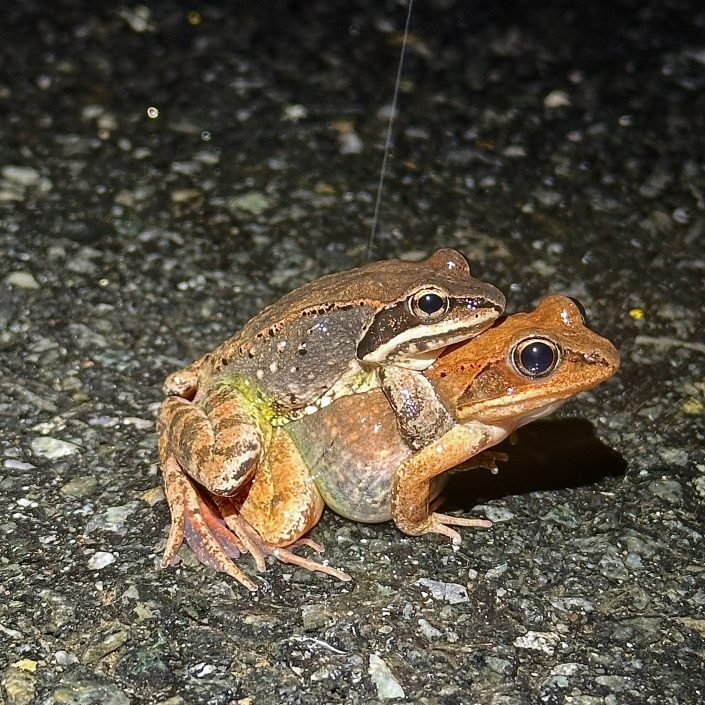Exploring New Jersey’s Amphibian Migrations
by Leah Wells, Wildlife Biologist

On rainy spring evenings, have you ever encountered large numbers of salamanders and frogs crossing the road? Do you ever wonder where they came from and where they are going? New Jersey’s forests are home to a group of amphibians that breed in small, temporary wetlands called vernal pools. Within northern New Jersey, this group includes wood frogs, spotted salamanders, and Jefferson salamanders.
These salamanders are elusive, often concealed under foliage, moss, or in burrows created by small creatures. They belong to the Ambystomatidae family, earning the nickname “mole salamander” due to their subterranean tendencies. Feeding primarily at night on various invertebrates like earthworms and insects, they, along with wood frogs, play crucial roles in forest ecosystems as vital links in the food chain and are indicators of ecosystem health. Emerging from winter hibernation during rainy nights in late winter and early spring, they embark on journeys to vernal pools for mating and egg-laying, marking the onset of the amphibian migration.
But why do we frequently encounter these amphibians crossing roadways? Migration distances to vernal pools can vary, ranging from a few hundred feet to over a quarter mile. However, habitat fragmentation of forests and wetland habitats due to development often forces these migrating amphibians onto roads, leading to high mortality rates among these slow-moving creatures. Conservation efforts, such as CWF’s Amphibian Crossing Project, help to guide amphibians safely across roads and have proven effective in reducing road mortality and safeguarding these remarkable migration phenomena.
This was my first year participating and leading one of the crossings in Swartswood State Park. While I normally work on our Bat Projects, being able to help out with new species is always an exciting experience. On our first crossing night of the season, I was a little unsure of what to expect. As soon as the sun set and the rain started to fall, the road became active with an abundance of wood frogs (284 to be exact) making their way towards the vernal pool. Our team of volunteers and myself were busy helping many of these frogs make their way across the road. We also helped across 15 spring peepers, 3 Jefferson salamanders, 1 spotted salamander, and 8 red-spotted newts. On our second crossing night of the season, most of our crossers were still wood frogs with a total of 308. A lot of them seemed to be returning to the woods from the vernal pool. Spring peepers were more active this night with a total of 58 of them crossing the roads towards the vernal pool. At the end of the night, we spotted the largest American toad I have ever seen. Being involved in the Amphibian Crossing Project was a special experience for me. It felt good that I was making a direct difference to the future of these animals.

Beyond the organized Rescue Nights at our three usual sites (Waterloo, Swartswood, and Hope), we have been working toward a goal of increased data collection and collaboration among different crossing entities during the 2024 season. Thanks to the dedication of our volunteer scouts, we gained insight into what the migration looks like across > 10 additional roadways that were either historically monitored or previously unstudied. The numbers and species distribution recorded at these locations will be submitted to NJDEP Endangered and Nongame Species Program for use in their Connecting Habitat Across New Jersey (CHANJ) initiative. We were, additionally, thrilled to establish closer ties with the Sourland Conservancy, who host their own Amphibian Crossing Guard project each spring, and the Somerset County Park Commission, who are in the process of setting up a similar volunteer effort where migrations coincide with county lands. While the early breeding salamanders are just about finished with their movement for this year, we look forward to working with these groups on amphibian conservation for years to come.

A big shout out to Industry Kitchen + Bar for their generous support of the Amphibian Crossing Project!

Discover more from Conserve Wildlife Foundation of NJ
Subscribe to get the latest posts sent to your email.